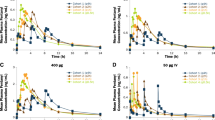Abstract
Objective
We have investigated the arterio–venous difference in the pharmacokinetics of 50 μg fentanyl during the first hour following nasal administration and documented its tolerability in opioid-naïve middle-aged to elderly patients.
Methods
Twelve male patients (range in age 47–84 years) scheduled for transurethral resection of the prostate gland received a 100-μl dose of 50 μg fentanyl base as a fentanyl citrate formulation in one nostril. Simultaneous arterial and venous blood samples for analyses of fentanyl were drawn at baseline and at 1, 3, 5, 7, 9, 13, 15, 20, 25, 35, 45 and 60 min after drug administration. Vital signs, sedation and symptoms of local irritation were recorded.
Results
The arterial Cmax (maximum serum concentration) of 0.83 ng/ml was nearly twofold higher than the venous Cmax of 0.47 ng/ml, and the arterial Tmax (time to maximum serum concentration) of 7.0 min was about 5 min shorter than the venous Tmax of 11.6 min. The arterial AUC0-60 (area under the curve from 0 to 60 min after administration) of 21 min*ng/ml was approximately 30% larger than the venous AUC0-60 of 15 min*ng/ml (all p values ≤ 0.005). Venous Tmax and Cmax did not predict the corresponding arterial values. No significant adverse events were observed.
Conclusion
A significant arterio–venous difference was present after intranasal administration of fentanyl. The short arterial Tmax complies with its rapid onset of action. The use of venous concentrations for the prediction of onset time of analgesia should be discouraged. A 50-μg dose of nasal fentanyl was well tolerated by opioid-naïve middle-aged to elderly male patients.

Similar content being viewed by others
Notes
Popper L, Christrup L., Poster abstract 664, 10th Congress of the European Association for Palliative Care, Budapest, Hungary, 7–9 June 2007.
Reference
Dale O, Hjortkjaer R, Kharasch ED (2002) Nasal administration of opioids for pain management in adults. Acta Anaesthesiol Scand 46(7):759–770
Glare P, Aggarwal G, Clark K (2004) Ongoing controversies in the pharmacological management of cancer pain. Intern Med J 34(1–2):45–49
Paech MJ, Lim CB, Banks SL, Rucklidge MW, Doherty DA (2003) A new formulation of nasal fentanyl spray for postoperative analgesia: a pilot study. Anaesthesia 58(8):740–744
Zeppetella G (2000) Nebulized and intranasal fentanyl in the management of cancer-related breakthrough pain. Palliat Med 14(1):57–58
Galinkin JL, Fazi LM, Cuy RM, Chiavacci RM, Kurth CD, Shah UK, Jacobs IN, Watcha MF (2000) Use of intranasal fentanyl in children undergoing myringotomy and tube placement during halothane and sevoflurane anesthesia. Anesthesiology 93(6):1378–1383
Striebel HW, Koenigs D, Kramer J (1992) Postoperative pain management by intranasal demand-adapted fentanyl titration. Anesthesiology 77(2):281–285
Chiou WL (1989) The phenomenon and rationale of marked dependence of drug concentration on blood sampling site. Implications in pharmacokinetics, pharmacodynamics, toxicology and therapeutics (Part II). Clin Pharmacokinet 17(4):275–290
Hermann DJ, Egan TD, Muir KT (1999) Influence of arteriovenous sampling on remifentanil pharmacokinetics and pharmacodynamics. Clin Pharmacol Ther 65(5):511–518
Rentsch KM, Kullak-Ublick GA, Reichel C, Meier PJ, Fattinger K (2001) Arterial and venous pharmacokinetics of intravenous heroin in subjects who are addicted to narcotics. Clin Pharmacol Ther 70(3):237–246
Guthrie SK, Zubieta JK, Ohl L, Ni L, Koeppe RA, Minoshima S, Domino EF (1999) Arterial/venous plasma nicotine concentrations following nicotine nasal spray. Eur J Clin Pharmacol 55(9):639–643
Scott JC, Stanski DR (1987) Decreased fentanyl and alfentanil dose requirements with age. A simultaneous pharmacokinetic and pharmacodynamic evaluation. J Pharmacol Exp Ther 240(1):159–166
Streisand JB, Varvel JR, Stanski DR, Le ML, Ashburn MA, Hague BI, Tarver SD, Stanley TH (1991) Absorption and bioavailability of oral transmucosal fentanyl citrate. Anesthesiology 75(2):223–229
Lennernas B, Hedner T, Holmberg M, Bredenberg S, Nystrom C, Lennernas H (2005) Pharmacokinetics and tolerability of different doses of fentanyl following sublingual administration of a rapidly dissolving tablet to cancer patients: a new approach to treatment of incident pain. Br J Clin Pharmacol 59(2):249–253
Lee M, Kern SE, Kisicki JC, Egan TD (2003) A pharmacokinetic study to compare two simultaneous 400 microg doses with a single 800 microg dose of oral transmucosal fentanyl citrate. J Pain Symptom Manage 26(2):743–747
Striebel HW (1993) Pharmakokinetische Studie zur intranasalen Gabe von Fentanyl. Der Schmerz 7(2):122–125
Dale O, Nilsen T, Loftsson T, Hjorth TH, Klepstad P, Kaasa S, Holand T, Djupesland PG (2006) Intranasal midazolam: a comparison of two delivery devices in human volunteers. J Pharm Pharmacol 58(10):1311–1318
Borgbjerg FM, Nielsen K, Franks J (1996) Experimental pain stimulates respiration and attenuates morphine-induced respiratory depression: a controlled study in human volunteers. Pain 64(1):123–128
Dale O, Hoffer C, Sheffels P, Kharasch ED (2002) Disposition of nasal, intravenous, and oral methadone in healthy volunteers. Clin Pharmacol Ther 72(5):536–545
Acknowledgements
The authors wish to thank Anette Arnberg, Pharm D, for the supply of nasal fentanyl from Nycomed Pharma. We are also grateful to Gunnhild Jakobsen R.N, and Anne Marie Lund M.Sc., for help with the data collection, Mari Sandrød Owesen R.N., for the recruitment of patients, Trine N. Andreassen M.Sc., for the opioid analyses, Johan Arnt Hegvik M.D., for cannulation and the staff at Recovery Unit and the Department of Urology for various assistance. We want to thank The Research Council of Norway and The Norwegian Cancer Society (E06096/002) for financial support. The study complies with the current Norwegian legislation.
Author information
Authors and Affiliations
Corresponding author
Rights and permissions
About this article
Cite this article
Moksnes, K., Fredheim, O.M., Klepstad, P. et al. Early pharmacokinetics of nasal fentanyl: is there a significant arterio-venous difference?. Eur J Clin Pharmacol 64, 497–502 (2008). https://doi.org/10.1007/s00228-007-0444-8
Received:
Accepted:
Published:
Issue Date:
DOI: https://doi.org/10.1007/s00228-007-0444-8




